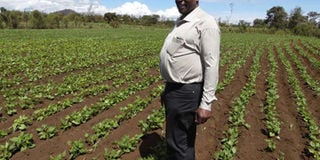Farmers learn to grow export beans

David Igweta at his farm in Meru County. PHOTO |CAROLINE WAMBUI|NATION MEDIA GROUP
What you need to know:
- In Kenya, it’s the most expensive bean variety as it has better characteristics which are consumer centered. Some Kenyan factories have also introduced pre cooked beans from the variety where they extract all the water from the bean and package them.
- Consumers are then supposed to only cook the beans for 15 minutes or so thus saving on fuel. The beans also do not require refrigeration
Some 10km from Meru town in Ruiri, Buuri Constituency, we find David Igweta supervising the weeding of a crop that has lately become not just dear to him, but to tens of other farmers in the region.
The day is bright and the sky is clear and as one looks yonder from Igweta’s farm, all that you see is a lush green crop.
The farmer is among 500 others in the county growing beans for export after being contracted by the Kenya Agricultural Livestock and Research Organisation (Kalro).
Igweta grows the KAT–X56 variety, which Kalro through traders exports to India and Middle East. The variety is among several drought-tolerant beans introduced by Kalro.
Others include Katumani Bean 1 (KAT B1) Kathika, Katumani Bean 9 (KAT B-9) Gacuma and Katumani (KAT X69).
Igweta, 53, who is also an agriculture high school teacher, farms the beans on six acres, besides growing coffee, potatoes, maize for silage and keeping dairy cows.
“I have been growing KAT–X56 since 2012 when it was introduced in the region by Kalro through Kenya Agricultural Productivity Project (KAPP),” he says.
Farm preparation
Two to three weeks before the onset of both the long and short rains, Igweta normally prepares his farm.
“I till twice to get a fine tilth of the soil but before I plant, the farm has to be inspected by the Kenya Plant Health Inspectorate Services officials. They visit three times during the life of the crop.”
He then makes drill drainage holes at a spacing of 45cm between rows and 15cm from one plant to another as he applies DAP fertiliser and mixes thoroughly with the soil.
Actual planting is then carried out at the onset of rains. Once the seeds germinate after about a week, the first weeding is carried out followed by application of a foliar fertiliser named Rosasol-P, which comprises of NPK 10:50:10.
Two weeks later, soluble Boron, a fertiliser is used for top dressing to stimulate and sustain flowering to avoid abortion, explains Igweta of the lessons he has picked.
The second weeding is done just before the crop flowers. After flowering, the crop is sprayed against pests and fungal infections.
“The beans mature in about three months with the yellowing of the leaves being the first indicator of maturity, followed by the yellowing of the pods. In three weeks the crop is dry and ready for harvesting. The beans yield 8-10 100kg bags per hectare,” says Igweta, who reveals that in a good year, he takes home some Sh600,000 from the project, enabling him to pay university fees for his daughter.
Sorting
The harvest is then sorted, graded and taken to a collection centre, where it is bought at Sh100 a kilo.
Flora Ikabu, the chairlady of Ruiri Cereal Growers farmers group, says beside knowing the best practices when growing beans, members have benefitted, including by installing electricity in their homes, buying motorcyles and starting dairy farms.
Dr Davis Karanja, the National Co-ordinator Grain Legume at Kalro, notes that the project, among other things, is teaching farmers how to grow the best beans amid adversity.
This is because beans are an important food crop in Kenya but growth is hindered by low rainfall, poor crop management, low fertility and use of inappropriate seed variety.
“Good bean seeds should be uniform, free from seed borne diseases and pest damage, should not be shrivelled, moldy, cracked or be rotten or discoloured,” he notes.
Katumani seeds
The Katumani seeds, according to Dr Karanja, are early maturing and tolerate to drought.
“They are high-yielding, cook fast and swell three times as compared to other bean varieties and are sweet,” Karanja says.
“They contain the characteristics that consumers look for. Consumers ask, do the beans swell, are they sweet, and do the beans give any gas in the stomach (flatulence)?”
Karanja notes that Kalro is strict when it comes to quality. They don’t collect low quality beans, which might arise due to insufficient rainfall and poor disease and pest control. With insufficient rainfall, the bean does not achieve the dark brown colour.
To be contracted, one has to be a member of a group through which there are rules and conditions to be complied with.
Thereafter, the farmers are trained on how to carry out proper production of certified beans on the drills, use of fertiliser and disease and pest control. Then one is supplied with the planting materials.
***
More varieties of good beans
- Other new varieties with a very high demand are “KAT B 1, which has a high demand in South Africa and Europe, specifically the Netherlands.
- In Kenya, it’s the most expensive bean variety as it has better characteristics which are consumer centered. Some Kenyan factories have also introduced pre cooked beans from the variety where they extract all the water from the bean and package them.
- Consumers are then supposed to only cook the beans for 15 minutes or so thus saving on fuel. The beans also do not require refrigeration.





